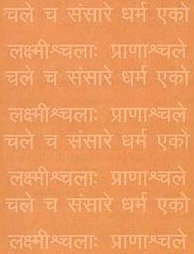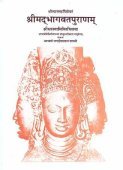Aila: 18 definitions
Introduction:
Aila means something in Hinduism, Sanskrit, Marathi, Jainism, Prakrit, biology. If you want to know the exact meaning, history, etymology or English translation of this term then check out the descriptions on this page. Add your comment or reference to a book if you want to contribute to this summary article.
In Hinduism
Purana and Itihasa (epic history)
Source: archive.org: Puranic Encyclopedia1) Aila (ऐल).—Son of Ilā; Purūravas. (See under Ilā).
2) Aila (ऐल).—A member of the court of Yamarāja. (See Śloka 16, Chapter 8, Sabhā Parva, Mahābhārata). In Śloka 65, Chapter 115 of Anuśāsana Parva, it is said that he never ate non-vegetarian food in his life.
Source: Cologne Digital Sanskrit Dictionaries: The Purana IndexAila (ऐल).—(Aiḍa)—surname of Purūravas; son of Budha and grandson of Soma; got six sons through Urvaśī; Aila to Kṣemaka, the last king of the lunar race; 100 branches of.*
- * Bhāgavata-purāṇa II. 7. 44; Brahmāṇḍa-purāṇa II. 28. 1-2; III. 74. 245. Vāyu-purāṇa 1. 106; 85. 17; 90. 45; 91. 10; 99. 266, 432, and 451; Viṣṇu-purāṇa III. 14. 11.
Aila (ऐल) is a name mentioned in the Mahābhārata (cf. I.89.55) and represents one of the many proper names used for people and places. Note: The Mahābhārata (mentioning Aila) is a Sanskrit epic poem consisting of 100,000 ślokas (metrical verses) and is over 2000 years old.
Source: Shodhganga: The saurapurana - a critical studyAila (ऐल) or Aila Purūravas is the name of an ancient king, according to the Vaṃśānucarita section of the 10th century Saurapurāṇa: one of the various Upapurāṇas depicting Śaivism.—Accordingly, [...] Aila Purūravas, the most illustrious pious king gets married to Urvaśī, the heavenly damsel who is cursed by Brahmā to spend sometime here on earth. Purūravas begets on her six sons—Āyu, Mayu, Amāyu, Viśvāyu, Śatāyu and Śrutāyu . All these are celebrated like Semi-divine beings (devayonaya).

The Purana (पुराण, purāṇas) refers to Sanskrit literature preserving ancient India’s vast cultural history, including historical legends, religious ceremonies, various arts and sciences. The eighteen mahapuranas total over 400,000 shlokas (metrical couplets) and date to at least several centuries BCE.
Vedanta (school of philosophy)
Source: Shodhganga: Siva Gita A Critical StudyAila (ऐल) or Ailagītā refers to one of the sixty-four Gītās commonly referred to in Hindu scriptures.—Gītā is the name given to certain sacred writings in verse (often in the form of a dialogue) which are devoted to the exposition of particular religious and theosophical doctrines. Most of these Gītās [i.e., Aila-gītā] originate from the Mahābhārata or the various Purāṇas.

Vedanta (वेदान्त, vedānta) refers to a school of orthodox Hindu philosophy (astika), drawing its subject-matter from the Upanishads. There are a number of sub-schools of Vedanta, however all of them expound on the basic teaching of the ultimate reality (brahman) and liberation (moksha) of the individual soul (atman).
Biology (plants and animals)
Source: Wisdom Library: Local Names of Plants and DrugsAila in the Hindi language is the name of a plant identified with Mimosa rubicaulis subsp. himalayana (Gamble) H.Ohashi from the Mimosaceae (Touch-me-not) family having the following synonyms: Mimosa himalayana. For the possible medicinal usage of aila, you can check this page for potential sources and references, although be aware that any some or none of the side-effects may not be mentioned here, wether they be harmful or beneficial to health.
Source: Google Books: CRC World Dictionary (Regional names)1) Aila in India is the name of a plant defined with Acacia caesia in various botanical sources. This page contains potential references in Ayurveda, modern medicine, and other folk traditions or local practices It has the synonym Mimosa intsia auct. non L. (among others).
2) Aila is also identified with Acacia concinna It has the synonym Senegalia rugata Britton & Rose (etc.).
3) Aila is also identified with Acacia pennata It has the synonym Mimosa ferruginea Rottler (etc.).
4) Aila is also identified with Acacia torta It has the synonym Acacia torta Craib (etc.).
5) Aila is also identified with Caesalpinia decapetala It has the synonym Biancaea scandens Tod. (etc.).
6) Aila is also identified with Mimosa rubicaulis It has the synonym Mimosa mutabilis Roxb. (etc.).
7) Aila in Papua New Guinea is also identified with Inocarpus fagifer It has the synonym Cajanus edulis (J.R. Forst. & G. Forst.) Kuntze (etc.).
Example references for further research on medicinal uses or toxicity (see latin names for full list):
· Adansonia
· Prodromus Systematis Naturalis Regni Vegetabilis (1825)
· Novae Plantarum Species (1821)
· Publications of the Field Columbian Museum, Botanical Series (1900)
· Familles des Plantes (1763)
· Leafl. Philipp. Bot.
If you are looking for specific details regarding Aila, for example pregnancy safety, side effects, health benefits, chemical composition, extract dosage, diet and recipes, have a look at these references.

This sections includes definitions from the five kingdoms of living things: Animals, Plants, Fungi, Protists and Monera. It will include both the official binomial nomenclature (scientific names usually in Latin) as well as regional spellings and variants.
Languages of India and abroad
Marathi-English dictionary
Source: DDSA: The Molesworth Marathi and English Dictionaryaila (ऐल).—ad On this or the near side. In comp. as ailatīra ailakāṇṭha.
--- OR ---
ailā (ऐला).—a Of this, the hither, or nearer side: opp. to pailā.
Source: DDSA: The Aryabhusan school dictionary, Marathi-Englishaila (ऐल).—ad On this or the near side; in comp. as ailatīra.
Marathi is an Indo-European language having over 70 million native speakers people in (predominantly) Maharashtra India. Marathi, like many other Indo-Aryan languages, evolved from early forms of Prakrit, which itself is a subset of Sanskrit, one of the most ancient languages of the world.
Sanskrit dictionary
Source: DDSA: The practical Sanskrit-English dictionaryAila (ऐल).—[ilāyā apatyaṃ aṇ]
1) Name of Purūravas (son of Ilā and Budha).
2) The planet Mars.
-lam 1 Food, a quantity of food.
2) A particular number.
Derivable forms: ailaḥ (ऐलः).
Source: Cologne Digital Sanskrit Dictionaries: Shabda-Sagara Sanskrit-English DictionaryAila (ऐल).—m.
(-laḥ) The name of a king, also Pururava. E. ilā the wife of Budd'Ha, aṇ patronymick affix; the son of Ila.
Source: Cologne Digital Sanskrit Dictionaries: Benfey Sanskrit-English DictionaryAila (ऐल).—i. e. iḷā (= iḍā) + a. A metronymic name of Purūravas, Mahābhārata 1, 3149.
Source: Cologne Digital Sanskrit Dictionaries: Cappeller Sanskrit-English DictionaryAila (ऐल).—[masculine] = aiḍa [masculine]
Source: Cologne Digital Sanskrit Dictionaries: Monier-Williams Sanskrit-English Dictionary1) Aila (ऐल):—m. ([from] ilā = iḍā), a descendant of Ilā, Name of Purūravas (cf. 1. aiḍa), [Harivaṃśa; Mahābhārata]
2) Name of the planet Mars, [Tārānātha tarkavācaspati’s Vācaspatyam, Sanskrit dictionary]
3) m. [plural] the descendants or family of Purūravas, [Mahābhārata xiii]
4) Ailā (ऐला):—[from aila] f. Name of a river ([varia lectio] elā), [Harivaṃśa]
5) Aila (ऐल):—n. plenty or abundance of food or refreshment
6) a particular number ([Buddhist literature])
Source: Cologne Digital Sanskrit Dictionaries: Yates Sanskrit-English DictionaryAila (ऐल):—(laḥ) 1. m. The name of a king.
[Sanskrit to German]
Sanskrit, also spelled संस्कृतम् (saṃskṛtam), is an ancient language of India commonly seen as the grandmother of the Indo-European language family (even English!). Closely allied with Prakrit and Pali, Sanskrit is more exhaustive in both grammar and terms and has the most extensive collection of literature in the world, greatly surpassing its sister-languages Greek and Latin.
Prakrit-English dictionary
Source: DDSA: Paia-sadda-mahannavo; a comprehensive Prakrit Hindi dictionary1) Āila (आइल) in the Prakrit language is related to the Sanskrit word: Āvila.
2) Āīla (आईल) also relates to the Sanskrit word: Ācīla.
Prakrit is an ancient language closely associated with both Pali and Sanskrit. Jain literature is often composed in this language or sub-dialects, such as the Agamas and their commentaries which are written in Ardhamagadhi and Maharashtri Prakrit. The earliest extant texts can be dated to as early as the 4th century BCE although core portions might be older.
See also (Relevant definitions)
Starts with (+19): Ailaba, Ailabakara, Ailabaluka, Ailabila, Ailabrida, Ailadhana, Ailadhani, Ailagita, Ailah, Ailaihang, Ailaka, Ailakasthiti, Ailakya, Ailalu picar, Ailamrida, Ailana, Ailani, Ailantal, Ailantalam, Ailantalmaram.
Ends with (+299): Ailapaila, Ailaphaila, Alaccemputaila, Amalaphaila, Ambarashaila, Ambutaila, Amrataila, Anaila, Angarataila, Ankolataila, Anutaila, Apamargaksharataila, Apamargataila, Aparashaila, Apraila, Ashaila, Ashtakatvarataila, Astashaila, Ataila, Avarashaila.
Full-text (+40): Ela, Ailadhana, Aina, Aida, Ailadhani, Ailamrida, Avila, Ailavamsha, Acila, Ailabrida, Pa'aila, La'au 'aila, Prayaga, Alikade, Alikadila, Urvashivallabha, Urvvashivallabha, Alikadala, Alikaduna, Vishvayu.
Relevant text
Search found 25 books and stories containing Aila, Ailā, Āila, Āīla; (plurals include: Ailas, Ailās, Āilas, Āīlas). You can also click to the full overview containing English textual excerpts. Below are direct links for the most relevant articles:
Garga Samhita (English) (by Danavir Goswami)
Verse 8.13.94 < [Chapter 13 - A Thousand Names of Lord Balarāma]
The Matsya Purana (critical study) (by Kushal Kalita)
Part 2.1c - The Lunar Dynasty < [Chapter 3 - Historical aspects in the Matsyapurāṇa]
Part 4 - Contents of the Matsyapurāṇa (summary) < [Chapter 1 - Introduction]
Mahabharata (English) (by Kisari Mohan Ganguli)
Section LXXIII < [Rajadharmanusasana Parva]
Section XXXIV < [Anusasanika Parva]
Section CLXV < [Anusasanika Parva]
Bhajana-Rahasya (by Srila Bhaktivinoda Thakura Mahasaya)
Text 16 < [Chapter 7 - Saptama-yāma-sādhana (Pradoṣa-kālīya-bhajana–vipralambha-prema)]
Text 24 < [Chapter 8 - Aṣṭama-yāma-sādhana (Rātri-līlā–prema-bhajana sambhoga)]
Chaitanya Bhagavata (by Bhumipati Dāsa)
Verse 2.13.148 < [Chapter 13 - The Deliverance of Jagāi and Mādhāi]
Verse 2.6.19 < [Chapter 6 - The Lord’s Meeting with Advaita Ācārya]
Verse 1.9.62 < [Chapter 9 - Nityānanda’s Childhood Pastimes and Travels to Holy Places]
The Gautami Mahatmya (by G. P. Bhatt)
Related products
